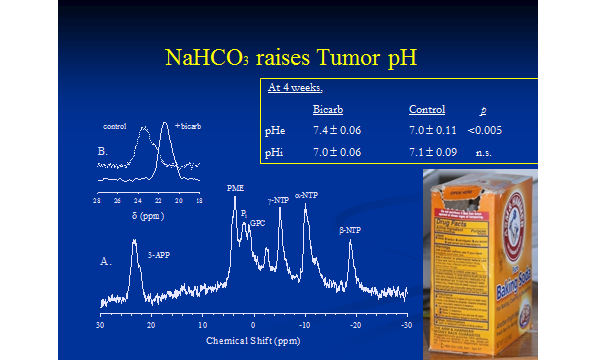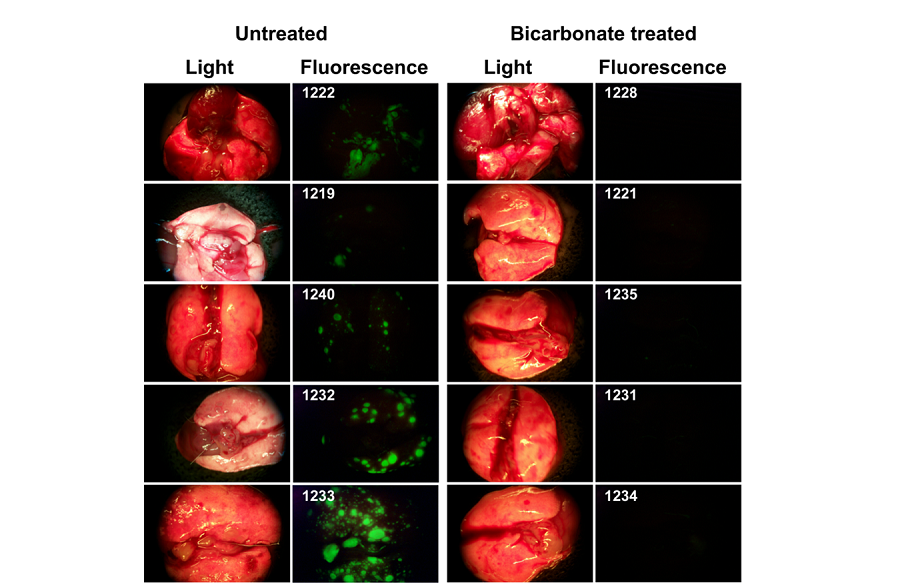Buffer Therapy
Project Summary:
We have shown in multiple systems that oral buffers (e.g., bicarbonate, Tris, lysine, imidazoles) specifically increase tumor pH without affecting systemic pH balance, rarely affect primary tumor growth, but potently inhibit experimental or spontaneous metastases (1-6). These effects are also manifest in genetically engineered mouse cancer models (GEMMs). For example, in the TRAMP prostate model, the initiation of buffer therapy at 4 weeks of age prevents emergence of cancer (7), but if administered after 10 weeks (after tumors are extracapsular), it has no effect on the primary tumor, but completely inhibits metastases (8).
Similarly, in the KPC pancreatic cancer and HER2/neu breast cancer mouse models, buffer therapy, when given early, delays tumor onset (Ibrahim-Hashim et al., in prep).

The effect of NaHCO3 treatment on tumor pH using magnetic resonance imaging spectrometer (Robey et al)
To translate these provocative studies into the clinic we initiated phase I/II clinical trials of buffer monotherapy in pain management trials (NCT01350583/ 01846429) and pancreatic cancer patients (NCT01198821). However, these trials failed due to poor compliance, poor taste, and/or GI intolerability. Thus, we propose to develop pharmacological alternatives to achieve the same result (i.e., reducing tumor acidity).

Lung metastases of mice bearing GFP-expressing MDA-mb-231 breast cancer xenografts treated with bicarbonate (Robey et al.)
References:
- Mahoney BP, Raghunand N, Baggett B, Gillies RJ. Tumor acidity, ion trapping and chemotherapeutics. I. Acid pH affects the distribution of chemotherapeutic agents in vitro. Biochemical pharmacology. 2003;66(7):1207-18. Epub 2003/09/25. PubMed PMID: 14505800.
- Raghunand N, Mahoney BP, Gillies RJ. Tumor acidity, ion trapping and chemotherapeutics. II. pH-dependent partition coefficients predict importance of ion trapping on pharmacokinetics of weakly basic chemotherapeutic agents. Biochemical pharmacology. 2003;66(7):1219-29. Epub 2003/09/25. PubMed PMID: 14505801.
- Robey IF, Baggett BK, Kirkpatrick ND, Roe DJ, Dosescu J, Sloane BF, Hashim AI, Morse DL, Raghunand N, Gatenby RA, Gillies RJ. Bicarbonate increases tumor pH and inhibits spontaneous metastases. Cancer research. 2009;69(6):2260-8. doi: 10.1158/0008-5472.CAN-07-5575. PubMed PMID: 19276390; PubMed Central PMCID: PMC2834485.
- Silva AS, Yunes JA, Gillies RJ, Gatenby RA. The potential role of systemic buffers in reducing intratumoral extracellular pH and acid-mediated invasion. Cancer research. 2009;69(6):2677-84. Epub 2009/03/12. doi: 10.1158/0008-5472.CAN-08-2394. PubMed PMID: 19276380; PubMed Central PMCID: PMC3718046.
- Ibrahim Hashim A, Cornnell HH, Coelho Ribeiro Mde L, Abrahams D, Cunningham J, Lloyd M, Martinez GV, Gatenby RA, Gillies RJ. Reduction of metastasis using a non-volatile buffer. Clinical & experimental metastasis. 2011;28(8):841-9. doi: 10.1007/s10585-011-9415-7. PubMed PMID: 21861189; PubMed Central PMCID: PMC3213349.
- Ribeiro M, Silva AS, Bailey K, Kumar NB, Sellers TA, Gatenby RA, Ibrahim Hashim A, Gillies RJ. Buffer Therapy for Cancer. J Nutr Food Sci. 2012;S2:1-7.
- Ibrahim-Hashim A, Cornnell HH, Abrahams D, Lloyd M, Bui M, Gillies RJ, Gatenby RA. Systemic buffers inhibit carcinogenesis in TRAMP mice. The Journal of urology. 2012;188(2):624-31. Epub 2012/06/19. doi: 10.1016/j.juro.2012.03.113. PubMed PMID: 22704445; PubMed Central PMCID: PMC3694604.
- Ibrahim-Hashim A, Robertson-Tessi M, Enriquez-Navas PM, Damaghi M, Balagurunathan Y, Wojtkowiak JW, Russell S, Yoonseok K, Lloyd MC, Bui MM, Brown JS, Anderson ARA, Gillies RJ, Gatenby RA. Defining Cancer Subpopulations by Adaptive Strategies Rather Than Molecular Properties Provides Novel Insights into Intratumoral Evolution. Cancer research. 2017;77(9):2242-54. doi: 10.1158/0008-5472.CAN-16-2844. PubMed PMID: 28249898.
Project Members
Arig Ibrahim-Hashim, MD
Research Scientist
